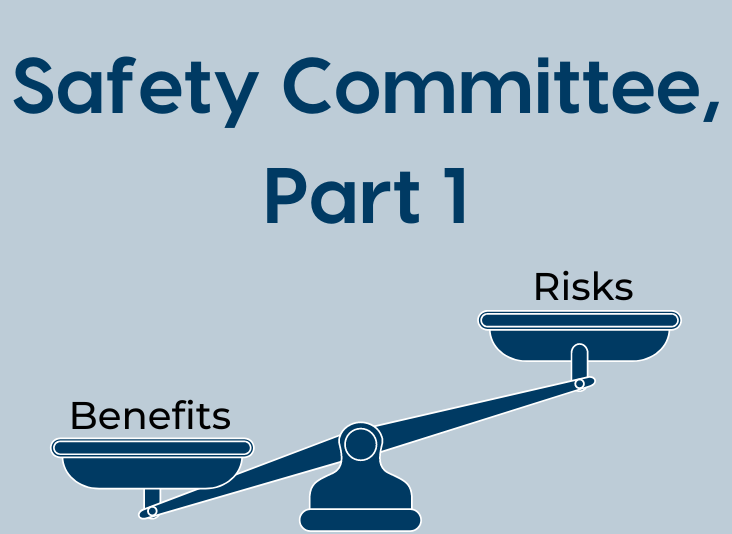Why You Should Implement an Organizational Safety Committee, Part 1: Benefits and Risks
Editor’s note: This is part one of a two-part series.
Safety is a crucial aspect of all operations. And while it’s easy to say that safety is important to your organization, actual safety program implementation is complex and requires organization-wide planning and cohesiveness. This is where an internal safety committee can yield important benefits and reduce workplace risks.
Operational Safety Is Key
No organization can be successful without prioritizing safety. Making safety a priority can lead to:
- Significant cost savings
- Increased productivity
- Improved employee retention and engagement
On top of this, all workers deserve protection, but unsafe worksite conditions result in accidents and injuries—and so directly threaten employee health and well-being. As is the overarching sentiment at Triumvirate Environmental: “Each and every one of our team members should leave work in the same, if not better, condition than how they came in.”
Operational Safety Gaps Downsides
Repeated or serious accidents can damage a company’s reputation. An organization with the stigma of risking its employees’ well-being also risks losing current or potential partners; moreover, the public will be less inclined to use its services or products. There are also both long-term direct and indirect negative financial consequences of unsafe practices, such as:
- Non-compliance penalties: Workplace injuries and accidents mean immediate monetary loss, in the form of fines from local, state, and federal regulators. The Occupational Safety and Health Administration, for example, can dole out fines of up to $15,625 per violation.
- Medical, administrative, lost time, and employee costs: Official penalties aren’t the only financial hit following a workplace accident. According to the National Safety Council, any workplace injury requiring a medical professional comes with an average price tag of $42,000; a workplace death can mean $1.3 million owed. Both of these numbers include associated employer costs as well as wage and productivity losses.
- Operational and workforce impacts: Organizations that demonstrate they care little for employee well-being are likely to face higher turnover than those that do protect workers. This, in turn, raises the cost of talent acquisition and retention—and incurs the loss of institutional knowledge. This means more operational disruption as skilled laborers transition to another organization—one with safer practices. In fact, it is estimated that companies spend between $4,000 and $20,000 to bring on each new worker—not including salary and benefit costs.
- Loss of customer revenue: In this age of high scrutiny, informed customers are reluctant to buy consumer products or services from companies that risk worker and public safety. This means reduced sales and damage to both top and bottom lines.
Studies that highlight the connection between safety and financial success are abundant—truly, safety is smart business.
Strong Safety Committees Provide Key Programs
One way that organizations can put safety at the forefront is by developing a safety committee. This could be a small or mid-sized group of dedicated and motivated employees from a variety of relevant internal departments who meet regularly to discuss and tackle safety issues or concerns logically and efficiently.
Within the safety committee, members should be encouraged to share ideas, raise concerns, and discuss key matters openly. In this way, lasting change and quick response can be utilized to maximize organizational safety.
Without a safety committee (or with one that is too exclusive), significant, widespread, and important progress simply won’t happen. In these instances, the entire burden of organizational safety usually falls to just one or two employees, who have other concerns and responsibilities and can’t always prioritize safety issues as they arise.
Skipping a Safety Committee: Dangerous Idea
A lack of a general, centralized, powerful safety committee can lead to a number of downsides, including:
- Internal staff may not feel like they have a voice to raise safety concerns or provide potential solutions to mitigate risk. This is discouraging and will hurt engagement.
- Staff members won’t have a dedicated team to bring safety concerns to—if they feel the power to raise them at all. They may assume someone is already addressing or will address these issues—resulting in inaction and thus exposing an organization to risk.
- Issues that arise will go unaddressed; some risks will be noted but not shared with the “safety officer.”
- Inaction towards these risks will mean more injuries and accidents.
- New equipment, supplies, and products will be purchased without a risk assessment. These products and materials can include everything from heavy equipment to chemical cleaners, PPE to biologics, and more. This practice will introduce hazardous gear and appliances into the organization—ones that workers won’t know how to safely operate, wear, or interact with and will thus cause disjointed operations.
A Strong, Efficient Safety Committee Adds Value
Inversely, a safety committee can provide a multitude of direct and indirect benefits. These may include:
- Rollout of safety performance monitoring and benchmarking systems: A safety committee will actively monitor operations, from procurement to training to shipment of products or delivery of services. As part of this, they can create a “near-miss” program” that tracks leading performance indicators and rates the relative safety of various processes or practices. Safety committee members can also offer after-action reviews (AARs) that evaluate safety successes and failures—all with the goal to implement improvements.
- Increased safety awareness: A powerful and vocal safety committee can increase overall organizational awareness of safety management best practices. They can also act as an informal internal marketing team whose goals are to educate staff about safety topics, upcoming trainings, and why safety is important.
- Decreased workplace injuries: Reduced risk and informed employees will mean a safer workplace with fewer injuries.
- Improved employee retention: With safety clearly an operational priority, workers will realize that management truly cares about them. This will boost morale and engagement as well as support long-term worker retention and improved performance. Put people over profit, and profit will outperform goals.
- Another opportunity for employee engagement: A safety committee provides a great forum, yet another opportunity for employees to be active in their work community and have their voices heard.
- Career development opportunities: Any given safety committee member may find that they are truly passionate about risk reduction. They may also find they are good at it—and take on new roles in the organization with greater responsibilities for reshaping its culture and operations. With a job they are passionate about, they may want to stay at the organization forever—thus creating an internal safety talent and expertise pipeline that will benefit the organization for years to come.
- Safer procurement: The safety committee will closely monitor buying decisions and ensure every new purchase comes with appropriate safety awareness and training.
- Financial gains: The Department of Energy reports that for every $1 spent on workplace safety programs, $4-$6 is saved. The trainings and awareness a safety committee will generate will help offset the costs of an unsafe workplace, as discussed above.
Interested in gaining all the benefits of a safety committee—while avoiding all the downsides and safety risks? Contact us today. Our team of dedicated consultants can help create and run your safety team or evaluate your practices and identify room for improvement. Also, keep an eye out for Part 2 of this blog series in which we will discuss key elements of a successful safety committee.







